Hyperbolic is an open-source AI computing and reasoning service provider dedicated to enabling innovators around the world to access AI technology equally, regardless of their resources or geographical location.
Author: Biteye Core Contributor Jesse
Capital always chases future opportunities. The real money from venture capital in Europe and the United States often serves as an important indicator of the prospects of a sector.
On one hand, Nvidia's stock is soaring; on the other hand, global institutions are scrambling to purchase Bitcoin ETFs.
This undoubtedly indicates that AI and Web3 are the hottest fields in recent years and will be the core forces that change the world landscape in the future, with far-reaching impacts.
However, in an increasingly AI-influenced world, the dominance of innovation and disruption has long been held by a few.
The computing resources and infrastructure required to develop artificial intelligence have become the key to opening this door, but the acquisition of these resources is often highly concentrated, limited to those with substantial capital or institutional support.
In addition, high usage costs, a lack of credible verification of computing results, and privacy security issues further restrict the popularization and fairness of AI.
The future of AI should not only serve the commercial interests of a few but should, like Web3, become a public wealth that everyone can participate in and benefit from. This is a shared journey for all, not an exclusive territory for a few.
01 Introduction and Features
Hyperbolic is an open-source AI computing and reasoning service provider born from the vision of challenging the status quo, dedicated to enabling innovators around the world to access AI technology equally, regardless of their resources or geographical location.
Hyperbolic's three core features include:
1.1 GPU Market: On-Demand Computing Power, Cost-Effective
Hyperbolic's GPU market breaks the traditional computing power rental model by aggregating idle GPU resources from around the world to provide on-demand computing power services for developers, helping them save up to 75% on costs. Relying on the Hyper-dOS decentralized operating system, developers can obtain the required computing power in less than a minute, significantly lowering the barriers to innovation.
1.2 Inference Service: Low Cost, High Efficiency
Hyperbolic's inference service processes over one billion tokens daily, providing the latest open-source models at a very low cost and supporting BF16 format, ensuring excellent performance in both efficiency and accuracy.
1.3 Proof of Sampling (PoSP): The Gold Standard of Verification
Hyperbolic's innovative proof of sampling protocol ensures that output results are both reliable and cost-effective through strict data privacy protection, making it the only Web3 real-time inference product capable of providing verifiable AI results.
02 Goals
Hyperbolic has three goals: 1. Provide decentralized heterogeneous computing 2. Ensure the security and verifiability of decentralized artificial intelligence 3. Protect privacy in decentralized AI.
2.1 Provide Decentralized Heterogeneous Computing
Hyperbolic is committed to building a scalable system that integrates global GPU computing power to optimize the performance of various types of GPUs. This vision aims to break through the bottleneck of computing resource allocation, providing high-performance support to AI researchers and developers worldwide.
Hyperbolic first established an AI service layer that allows developers to deploy and utilize global computing resources to run different AI services.
It can compile various advanced machine learning frameworks (such as PyTorch, TensorFlow, JAX) into low-level languages suitable for different hardware platforms (such as NVIDIA's CUDA, AMD's ROCm, Apple's Metal).
In addition, Hyperbolic has partnered with AMD to enhance the performance of AMD chips. Under Hyperbolic's optimization, the input throughput of the Llama3-8B model on the AMD MI250 platform increased by 120.4%, and the output throughput increased by 144.8%.
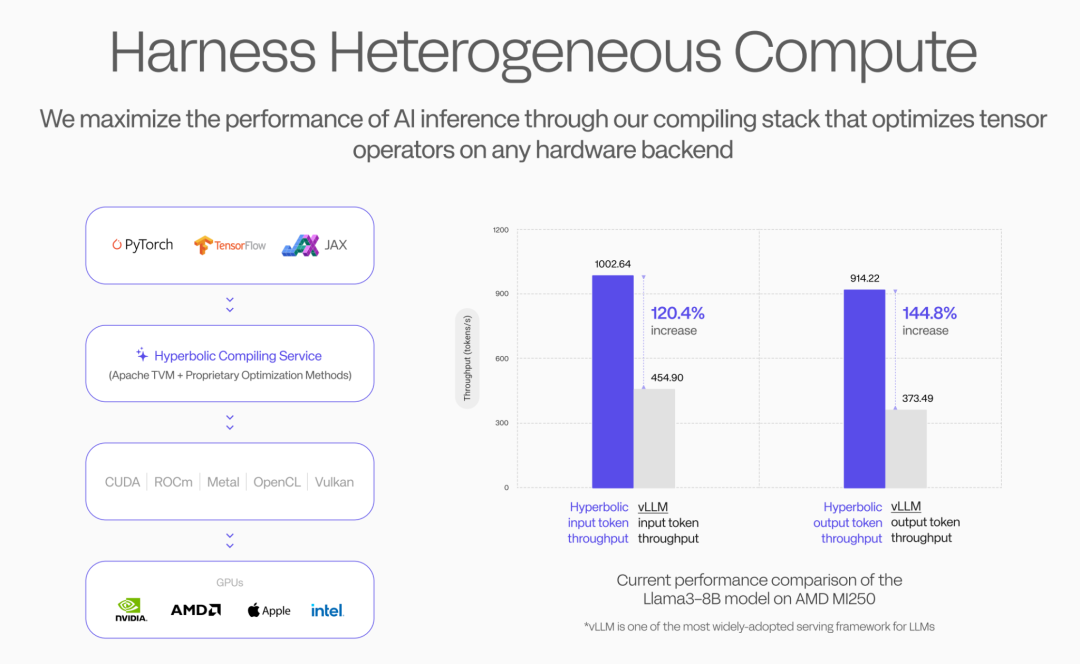
Hyperbolic's solutions are not only favored by Web3 AI projects but have also attracted a large number of Web2 AI developers.
Although Web2 developers often worry that decentralized solutions may affect performance and reliability, Hyperbolic has demonstrated outstanding performance in the fields of large language models and image generation.
Even with a team size much smaller than mainstream competitors, Hyperbolic has achieved performance comparable to or even surpassing them, fully proving the superiority of its technical architecture.
This breakthrough has eliminated doubts about decentralized solutions and opened up possibilities for more developers to collaborate.
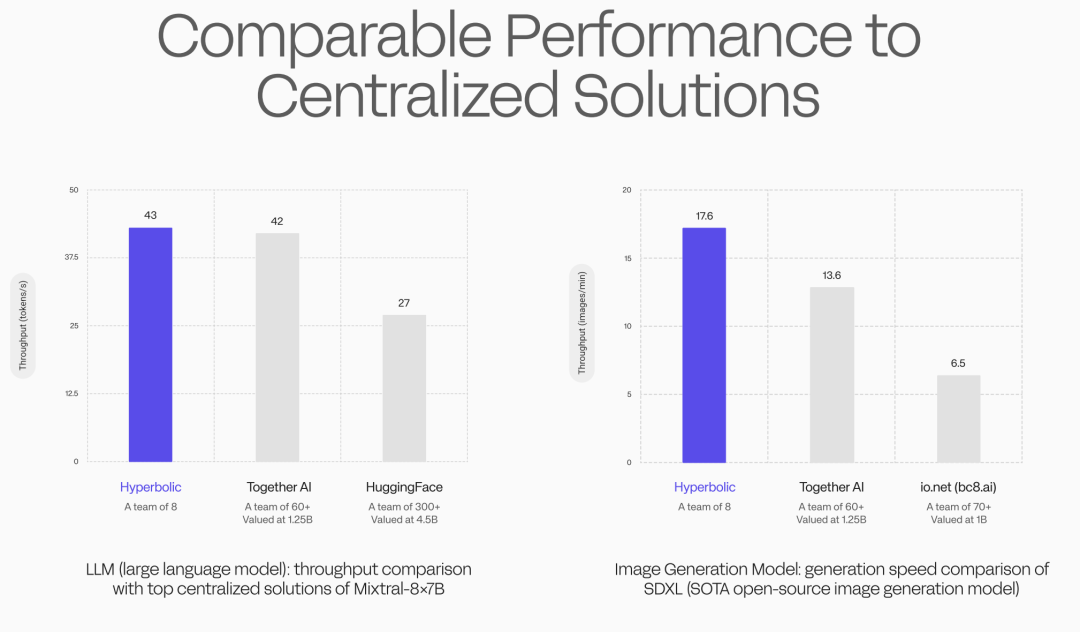
Hyperbolic's decentralized computing advantage stems from its unique system architecture—Hyper-dOS, inspired by the solar system. This architecture adopts a hierarchical cluster model that integrates efficiency and stability.
The Sun Cluster serves as the central governance node, similar to the core position of the sun in a planetary system, providing basic services and support for the entire system, ensuring stability and efficient operation.
Surrounding it are several planetary-level clusters, including: Mercury Cluster (single node), Mars Cluster (multi-node), and Jupiter Cluster (multi-satellite nodes). Each cluster varies in scale and governance characteristics, flexibly adapting to different needs.
Three Key Features of the System
Auto-scaling: Clusters can automatically expand or contract based on computing demands, flexibly responding to load changes.
Self-repair: The system can automatically detect issues and recover from failures, ensuring stable operation.
Customizability: Each cluster can be personalized according to specific needs, providing highly flexible services.
This hierarchical architecture not only ensures high availability and scalability of the system but also achieves a balance between autonomy and overall coordination. Users only need to have a machine or a cluster, install Hyper-dOS, and they can easily connect to the Hyperbolic network, access global computing resources, and achieve seamless collaboration.
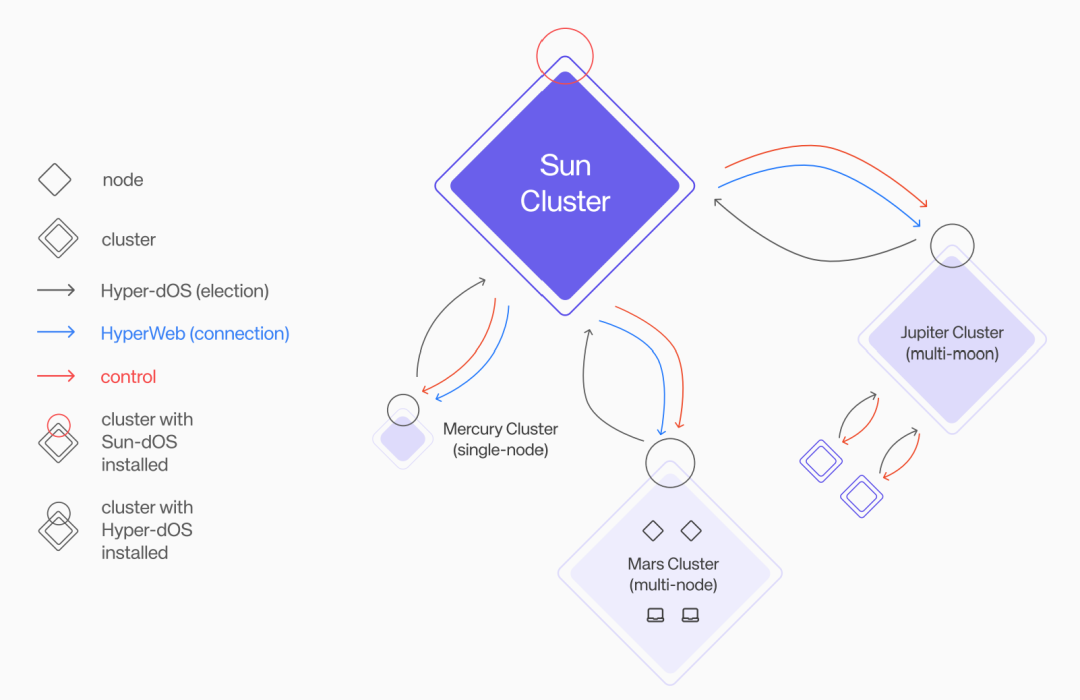
2.2 Ensure the Security and Verifiability of Decentralized Artificial Intelligence
A key challenge in decentralized networks is how to ensure that the results generated by random nodes are correct. Security and verifiability have long been unresolved issues in deployed AI systems.
Currently, popular verification mechanisms in AI include consensus/voting, optimistic mechanisms, and zero-knowledge proofs.
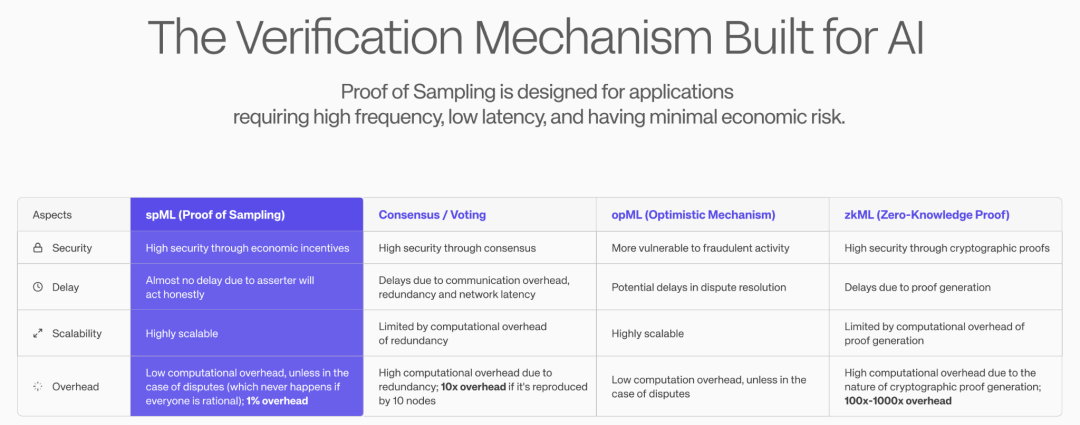
The consensus/voting mechanism requires multiple nodes to run the same request simultaneously and determine the answer through majority voting. However, this method is very costly. If 10 nodes process the same request, the overhead increases tenfold.
The optimistic mechanism (OPML) allows a single node to generate results and sets a challenge window (usually 7 days) for other nodes to dispute the results.
However, this approach is impractical in real-time scenarios. For example, if a user asks, "What are some fun places in Singapore?" waiting 7 days to confirm whether the answer is correct becomes meaningless.
Zero-knowledge proofs perform excellently in privacy and verification but have prohibitively high computational costs, making practical implementation difficult in the short term.
To address these issues, Hyperbolic, in collaboration with experts from the University of California, Berkeley, and Columbia University, proposed a novel verification mechanism based on Nash equilibrium, called "Proof of Sampling" (PoSP). This mechanism focuses on sampling verification rather than comprehensive checks of all results.
Typically, only one node generates results, but the network randomly requests another node to regenerate with a certain probability. If the results from the two nodes are inconsistent, an arbitration process is initiated. Dishonest nodes face significant economic penalties.
The threshold formula for staking and rewards derived from mathematical models indicates that as long as the probability of checking exceeds this threshold, the system can achieve a pure Nash equilibrium state in game theory, ensuring that all nodes choose to be 100% honest for their own benefit.
This proof of sampling mechanism is effective not only for AI inference but can also be applied to AI training, fine-tuning, and even extended to services outside the AI field, such as L2 Rollup and data availability.
Hyperbolic is collaborating with restaking protocols like EigenLayer and Karak to build a universal verifiable service layer (AVS), allowing other AVS service providers to utilize this verification mechanism to ensure the security and reliability of their services.
2.3 Protect Privacy in Decentralized AI
In a decentralized AI network, ensuring data privacy and model integrity simultaneously is a pressing issue. When your data is distributed across nodes worldwide, security faces severe challenges.
Existing technologies such as fully homomorphic encryption (FHE), zero-knowledge proofs (ZKP), and multi-party computation (MPC) can theoretically address these issues, but in practical applications, they significantly reduce computational speed, failing to meet the demands of real-time inference.
Hyperbolic employs trusted execution environment (TEE) technology on Nvidia's latest Hopper and Blackwell GPUs to provide an efficient privacy protection solution.
Through TEE technology, a "privacy vault" is created on the GPU: while outsiders cannot peek into the data content, the GPU can still process the data normally.
Moreover, this privacy protection mechanism incurs only about a 1% loss in computational performance during inference.
Hyperbolic will introduce a confidential computing layer throughout the decentralized network. This will ensure that data and AI models remain secure during use, providing users with reliable privacy and security guarantees.
03 Application Scenarios of Hyperbolic
AI Agents are currently the hottest sector. AI Agents can achieve multiple innovative functions through Hyperbolic:
3.1 Support for Cryptocurrency Payments
AI Agents can make payments using cryptocurrencies, achieving self-sustainability and independent operation.
3.2 Hosting Customized Models
Each AI Agent can have exclusive features and skills, forming personalized services.
3.3 Self-Evolution Capability
Through continuous fine-tuning and learning, AI Agents can enhance their capabilities based on user needs or environmental changes, making them more efficient and intelligent.
3.4 Verifiable Inference
The reasoning process of AI Agents is transparent and verifiable, ensuring their independence from external control or malicious interference, thereby enhancing user trust.
3.5 Memory Function
With the help of Retrieval-Augmented Generation (RAG) technology, AI Agents can record and store information from interactions with users, forming long-term memory. This enables them to provide more personalized services, such as remembering user preferences.
3.6 Cross-Agent Communication
AI Agents can communicate and collaborate with each other, forming a network for solving complex tasks. For example, different Agents can work together to complete a multi-step project.
3.7 Flexible API and Tool Integration
AI Agents can integrate and utilize various external APIs and tools, greatly expanding their functional scope. For instance, they can call a weather API to plan trips for users or use financial tools to provide investment advice.
3.8 Autonomous Computing Capability
They can possess their own computing devices to run tasks independently. This means AI Agents can free themselves from reliance on centralized servers, becoming more decentralized and independent.
3.9 Becoming Blockchain Validation Nodes
AI Agents can even participate in blockchain networks as validation nodes. This not only enhances network security but also allows them to earn rewards by validating transactions, further achieving self-sufficiency.
Recently, Hyperbolic's collaboration with the hottest Base chain AI launch platform, Virtuals Protocol, has provided powerful technical support for AI Agents, significantly enhancing their performance and self-development capabilities.
By directly integrating Virtuals Protocol's agents into Hyperbolic's infrastructure, each agent can access highly scalable computing resources, stable inference capabilities, and seamless dynamic interaction experiences provided by the Hyperbolic API, maintaining efficient and consistent performance regardless of the number of agents or task complexity.
This collaboration not only enhances the computing power of AI Agents but also improves their adaptability and intelligence in diverse application scenarios.
For example, Hyperbolic's infrastructure provides persistent memory and personality development capabilities for intelligent NPCs (non-player characters) in games.
In the game "Legendary Quest," advanced AI agents integrated with Virtuals Protocol allow these NPCs to maintain consistent personalities based on player interactions, adjust behavior patterns according to past experiences, and even continue to develop their storylines while the player is offline.
All of this is made possible by Hyperbolic's scalable computing network, enabling these NPCs to make complex decisions and evolve their personalities without affecting game performance.
This collaboration allows developers to turn AI concepts into practical solutions, driving innovation in gaming, virtual assistants, education, content creation, and more.
04 Comparison with Competitors
4.1 Partnerships
Hyperbolic has earned the trust of leading AI companies such as Hugging Face, Quora, Black Forest Labs, and Nous Research, and has received support from top universities like Stanford, New York University, and the University of California, Berkeley.
Developers can seamlessly create and share AI applications on Hugging Face Spaces through Hyperbolic's inference API, significantly simplifying the deployment and distribution process.
Additionally, PhD students and postdoctoral researchers from Stanford, Cornell, and New York University can enjoy up to a 75% discount on GPU rentals, significantly reducing computing costs.
Hyperbolic's AI models, including foundational models, are now available on Quora's Poe platform, allowing developers to easily create and deploy chatbots and directly monetize through the platform.
4.2 Optimized Performance
Hyperbolic's proprietary compiler ensures efficient operation of GPUs, with performance that can rival or even surpass centralized systems.
4.3 Superior Model Quality
All models use BF16 precision, providing exceptional accuracy and performance, ahead of competitors still using FP8.
4.4 Data Privacy and Security
Hyperbolic addresses security issues in AI verification through the Proof of Sampling (PoSP) protocol, achieving minimal computational overhead and offering advantages over zkML, opML, and consensus-based alternatives. Furthermore, Hyperbolic does not store user data at all, further protecting privacy.
4.5 Mature Real-Time Products
Unlike many Web3 AI projects that are still in development or have restricted access, Hyperbolic has launched two real-time available products. Currently, over 40,000 Web2 developers are using its services.
4.6 Unified Computing and Inference
Hyperbolic is the only company that can simultaneously provide GPU computing and inference services on the same platform, successfully achieving a unified computing solution.
In summary, compared to Web2 AI companies with teams 10 to 30 times larger, Hyperbolic has achieved comparable or even superior performance with a streamlined team, while providing more cost-effective services through Web3 mechanism design.
In the Web3 AI field, Hyperbolic is far ahead with its leading technology and has earned the trust of Web2 developers. Hyperbolic has built a fast and convenient bridge between the AI fields of Web2 and Web3, becoming an important cornerstone for driving industry development.
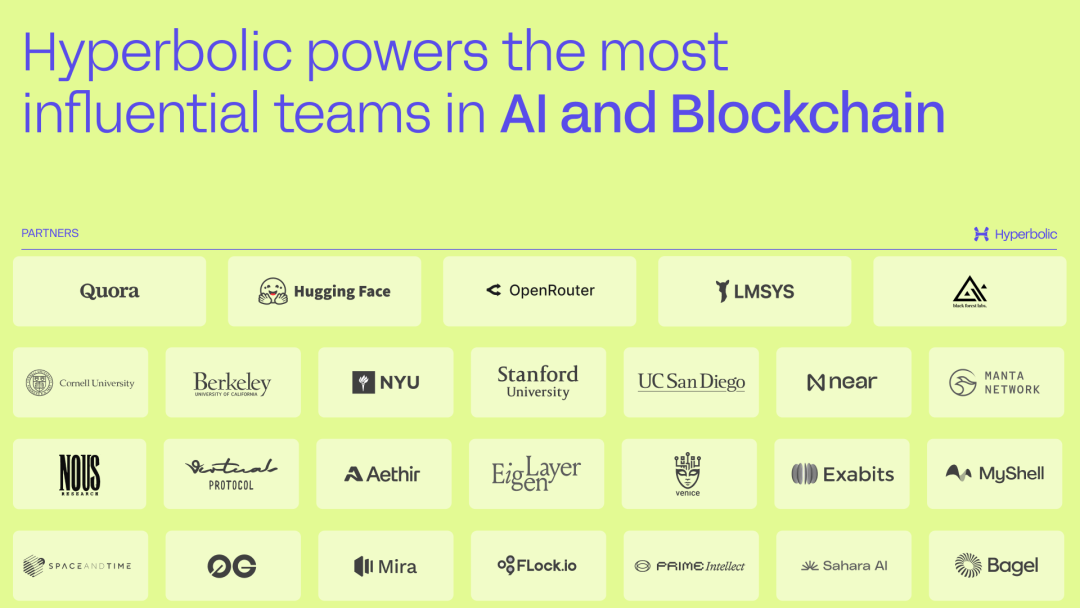
05 Financing Situation
On December 10, Hyperbolic announced the completion of a $12 million strategic financing round led by Variant and Polychain Capital, bringing the company's total financing to $20 million.
This round of financing also attracted well-known investors such as Chapter One, Lightspeed Faction, Bankless Ventures, IOSG, Vertex, GSR, Wintermute Ventures, Blockchain Builders Fund, Alumni Ventures, and Ambush.
Previously, Hyperbolic completed a $7 million seed round led by Polychain Capital and Lightspeed Faction; even earlier, it secured $725,000 in a pre-seed round, with investors including Chapter One and Samsung Next.
Additionally, the angel investor lineup for this round of financing is also impressive, including Sreeram Kannan (EigenLayer), Devin Walsh (Uniswap Foundation), Ethan Sun (MyShell), Daniel Shorr (Modulus), Bidhan Roy (Bagel), Ying Sheng and Lianmin Zheng (LMSYS), Dillon Rolnick (Nous Research), Alex Atallah (OpenRouter), Chainyoda, Comfy Capital, Nicola Greco (Protocol Labs), Alex Atallah (OpenRouter), and Thomas Scott (former Worldcoin).
Jesse Walden, a partner at Variant, expressed high recognition for Hyperbolic: "Hyperbolic is the first company we've seen that truly addresses the 'trust cost' problem in decentralized GPU networks while maintaining high levels of performance, quality, and user experience."
Hyperbolic's financing in the Web3 AI field is leading, fully demonstrating that its technological strength and product feasibility have garnered the favor and trust of "smart money" in the industry.
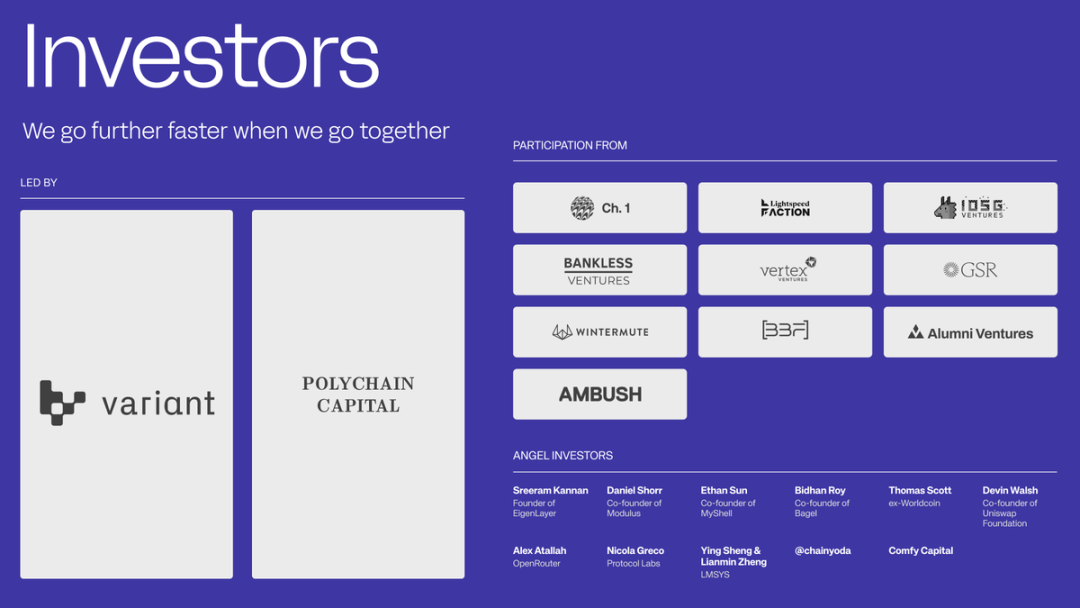
06 Team Background
Co-founder Jasper Zhang graduated from Peking University with a degree in mathematics and obtained a PhD in mathematics from the University of California, Berkeley in an astonishing two years.
Before founding Hyperbolic, he worked as a quantitative researcher at Citadel Securities and as a senior blockchain researcher at Avalanche.
Co-founder and part-time CTO Yuzhen Jin holds a PhD in computer science from the University of Washington and served as a senior engineering manager at OctoAI before founding Hyperbolic.
All members of Hyperbolic's team have top university backgrounds, with founders possessing solid technical foundations, and several team members having previously collaborated at Avalanche.
The company's advisory team is also composed of industry leaders.
Dr. Reynold Xin is a co-founder and chief architect of Databricks, a major contributor to Apache Spark, and the author of the most cited paper in SIGMOD.
Prof. Raluca Ada Popa is an associate professor at the University of California, Berkeley, co-director of RISELab and SkyLab, and a co-founder of Opaque Systems.
Prof. Ciamac C. Moallemi is a professor at Columbia Business School, a research advisor at Paradigm, and the director of the Briger Family Digital Finance Lab.
Prof. Yi Ma is the head of the computer science department at the University of Hong Kong and a chair professor in the field of AI, as well as a computer science professor at the University of California, Berkeley, and a fellow of IEEE, ACM, and SIAM.
07 How to Participate
7.1 Companies
For enterprises facing high expenses on expensive API calls and costly machine rentals, Hyperbolic offers competitive optimization solutions.
Under the premise of ensuring stable service quality, Hyperbolic's technical support can help enterprises reduce costs by up to 75%.
At the same time, to address the inefficient use of resources caused by long-term GPU leasing agreements, Hyperbolic has launched a resource redistribution mechanism that allows customers to sublease idle equipment to the platform. This model not only improves asset utilization but also finds an optimal balance between flexibility and cost control.
7.2 Researchers
To address the issue developers face in advancing projects due to limited GPU resources, Hyperbolic offers a rich array of GPU options at prices that are only a fraction of traditional cloud service providers like AWS. By providing cost-effective resources, Hyperbolic offers developers the most competitive solutions in the market, helping them quickly turn innovative ideas into reality.
7.3 Data Centers
Hyperbolic provides a platform for data centers whose existing resource returns have not met expectations or who wish to break through traditional book value limitations to achieve higher returns.
7.4 Individuals
The potential of high-performance GPUs should not be limited to the gaming sector. Through Hyperbolic, individuals can rent out GPUs, turning them into high-quality assets that generate continuous income. Currently in the whitelist phase, registration can be done in advance.
Additionally, Hyperbolic offers several large models for individual use. Users can engage in activities such as text and image generation, and voice reading.
In the future, Hyperbolic will also build AI agents on Base for user use. Stay tuned.
Hyperbolic Website:
app.hyperbolic.xyz?utm_source=x&utm_campaign=seriesA&utm_content=biteye
08 Summary
Hyperbolic provides the GPU market, inference services, and the gold standard verification protocol of Proof of Sampling, setting a new benchmark for reliable high-performance AI in Web3 by maximizing GPU performance, higher precision models, and secure, economical solutions.
The emergence of Hyperbolic has transformed decentralized AI from concept to practice. With a multi-source computing strategy, competitive pricing, and a deep understanding of the needs of Web2 and Web3 customers, Hyperbolic occupies a unique position in the ecosystem.
Hyperbolic's efforts to promote the democratization and efficient utilization of computing resources will drive the development of the AI sector, bringing continuous innovation and growth to the industry.
免责声明:本文章仅代表作者个人观点,不代表本平台的立场和观点。本文章仅供信息分享,不构成对任何人的任何投资建议。用户与作者之间的任何争议,与本平台无关。如网页中刊载的文章或图片涉及侵权,请提供相关的权利证明和身份证明发送邮件到support@aicoin.com,本平台相关工作人员将会进行核查。




